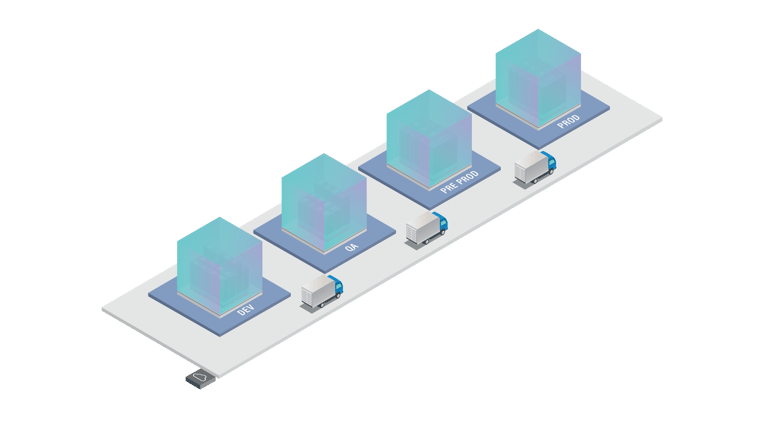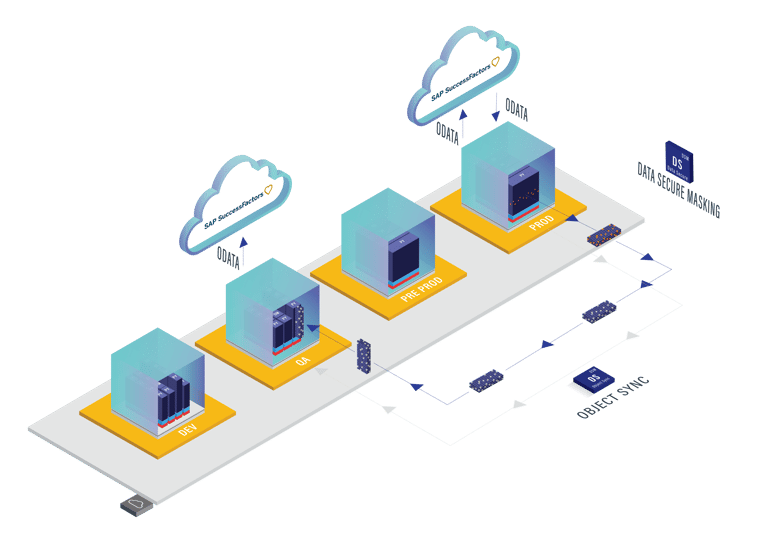Protect your data in non-production instances in SAP SuccessFactors
By Danielle Larocca | 07 January 2021
It’s easy to keep your multiple instances and employee data synced and secure, in your SAP SuccessFactors landscape
You need secure access to your critical HCM and Payroll production data in non-production systems for testing, training and support. If you’re in SAP SuccessFactors Hybrid scenarios or with SAP SuccessFactors Employee Central Payroll, you currently have limited options for how to accomplish this.
The ‘Transport Truck’ in on-premise ECC SAP
In on-premise ECC SAP, you have different environments often titled Development, QAS and Production, and system configuration and customizing is transported between them. The methodology is that items are configured in the Development client, unit tested there and then transported to a QAS client for potential system, integration and regression testing, and then on to a Production client for live use. In the on-premise world, this makes it relatively easy to have organizational structures, objects and employee data synchronized between clients. Many of our clients leverage Data Sync Manager™ (DSM) for HCM to solve this challenge. DSM gives you the data you need, when you need it. This SAP-certified solution allows you to select and transfer specific HCM data objects easily and accurately, as needed, and to mask sensitive data for confidentiality, security and governance compliance.
SAP Transport methodology between clients

There is no ‘Transport Truck’ in SuccessFactors
In the SuccessFactors landscape, however, although there are multiple environments which are referred to as instances, similarly named as Development, QAS and Production, there is not that same concept of transporting configuration methodology where things get moved between those environments. Because of this, system configuration is easily out of sync between the environments, which in turn makes it difficult to share objects and employee data across the various instances. Organizations need to realign object definitions, picklist entries, business rules, etc. across their SuccessFactors instances, and then enforce correct change management, more akin to the SAP Transport Management System in the on-premise world, but without the same tool. Some configurations can be downloaded and uploaded, but many are still manual. Processes and procedures must enforce that new changes are made and tested before being promoted.
Testing is only as good as the data and customizing
Without aligned configuration, the testing is, at best, compromised. The quality of the test data also has a big part to play. Just like in the on-premise SAP system, there is no easy way to generate synthetic realistic test data, and so real production data is generally favored. At a high level, as a SuccessFactors customer, you have limited options for moving and masking data between your environments:
-
You can request a copy of the entire instance (test becomes a copy of Production, for example)
-
You have limited abilities to take entities and their properties from one environment to another.
Again, we provide a solution to this challenge for getting your data from your hybrid SuccessFactors Production instance to your other instances, and it includes important data masking options to ensure that your confidential data stays secure.
We have expanded the functionality for our SAP-certified DSM Object Sync for HCM solution to include similar functionality if you are running in an SAP SuccessFactors Hybrid model or running with any form of SAP SuccessFactors Employee Central Payroll. This solution is also whitelisted to run on SuccessFactors Employee Central Payroll as per SAP Note 2167337, and this solution does not require a license for SCP.
(DSM) Object Sync for HCM SuccessFactors Add-On automatically ensures the consistent copying and masking of Employee Central data at the same time. The SuccessFactors identity is defined in the source and target ABAP stack system, and when employee data is exported, OData get-calls are made to the corresponding SuccessFactors system via this identity. Data for both systems is then scrambled simultaneously to ensure matching values still match, and then on the target system the SuccessFactors data is posted via the corresponding OData identity assigned to the target, again leveraging the OData API. This is why there is no requirement for SCP or any other platform beyond the existing ABAP systems.
Here is a quick overview of how our (DSM) Object Sync for HCM SuccessFactors Add-On works behind the scenes:
Watch a live system demonstration showing the copying and masking of data:
The solution includes a utility to identify if Foundation Objects are out of sync.
In implementing our (DSM) Object Sync for HCM SuccessFactors Add-On, we've discovered Foundation Objects and their configuration aren't always aligned between Production and Test systems. This video shows the utility we now include with the license that allows you to view entities with their Nav relations, make changes to property values, and then post to the target SuccessFactors instance.
Here is a video of it in action:
DSM was initially developed specifically for HCM, but later became available for other SAP ERP applications including FI and LO, SRM, CRM, SCM, GTS and BW. DSM is certified as integrated with SAP S/4HANA.
Danielle Larocca
With over 20 years in SAP Human Capital Management, Danielle is a recognized leader in HR technology. She holds the distinguished roles of SAP Mentor and SuccessFactors Confidant, and serves as HCM Chairperson for ASUG (America's SAP User Group). Danielle is a sought-after speaker at international conferences, sharing insights on HR tech trends. She has authored four best-selling books on SAP and holds certifications in both SAP and SuccessFactors technologies.
